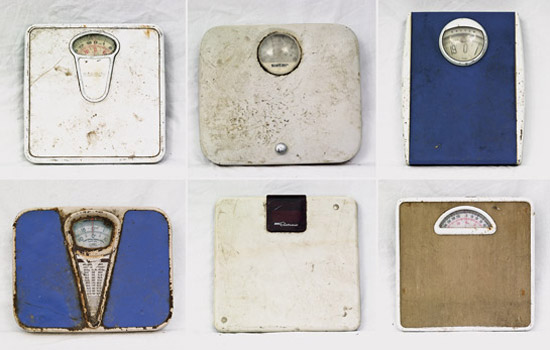Priestess of pixels practices what she preaches
Katrin Eismann
This intriguing photo of discarded bathroom scales is from Eismann's 2008 trip to Tasmania.
The name of her Web site—“Photoshopdiva.com”—is a tipoff.
Katrin Eismann ’91 (photo illustration) embraced digital imaging when she was a student at RIT. Since then, she has become a recognized authority in the field, with particular expertise in the powerful digital imaging tool, Adobe Photoshop.
She has written or co-authored seven books and DVDs including The Creative Digital Darkroom (O’Reilly Books, 2008) and three editions of Photoshop Restoration & Retouching (New Riders Publishing, third edition 2005).
But her Photoshop work is just part of the picture. Eismann chairs the Masters of Professional Studies in Digital Photography program at the School of Visual Arts, New York City, and also conducts seminars and workshops worldwide.
In addition, she continues to pursue her personal artistic work—which was her impetus for exploring digital photography.
“When I was a student at RIT, I saw other students working on computers doing what I was trying to accomplish in the darkroom,” she recalls.
After the initial discovery, deeper involvement in digital imaging came when she became the first intern at Kodak Center of Creative Imaging in Camden, Maine. She stayed on to become director of education, developing and implementing curricula focused on imaging, design and multimedia.
Teaching became her way of countering the proliferation of interesting work spoiled by poor technique and inferior printing. Or, sometimes she saw the opposite—and as Ansel Adams described, “There is nothing worse than a sharp image of a fuzzy concept.” With her books, lectures, and classes she tries to help photographers bridge the chasm between digital technology and personal artistic expression.
“It is essential to balance technology with aesthetics, all in the service of creating better images,” she says. For Eismann, the two are equally fascinating.
The “Photoshop diva” remains an active photographer, with a camera always close at hand. “I learned that at RIT,” she says. “Willie Osterman [professor, School of Photographic Arts and Sciences] would check to see if you had your camera with you at all times.”
Today, a Canon G10 is her “carry around” camera, and she has a Canon D40 for travel. And she still uses the Hasselblad 503 she won when she was at RIT, only now instead of using the original film backs she uses it with a Phase One P25+ digital capture back. That was the camera she took on her April 2008 trip to Tasmania as part of a group of 18 internationally known photographers participating in the Adobe Lightroom Adventure.
“I knew I wanted to take the time to do a unique body of work,” she says. Rather than focussing on the spectacular landscape or the unique culture, she found her inspiration at the Hobart city dump, where she captured the portraits of discarded objects to reveal the respectful relationship the Tasmanian people have with nature.
Her RIT experience also found its way into her latest book, The Creative Digital Darkroom.
“I try to translate the traditional way of thinking and working in the wet darkroom—of working with tongs and scuffed yellow developer trays—into the digital world,” she explains. “At RIT, I developed the important skill of looking at a print and determining what is needed to improve it. With digital technology it’s easy to be distracted with many choices, but by envisioning the goal of the image, the creative decisions are much easier to make.”
The book, she says, is aimed at dedicated amateurs as well as professionals who need to get up to speed on digital processing. “My books,” she says, “always have a goal. They are much more than ‘Here is how a tool works;’ rather they address ‘Here’s what you can do with the tools.’”
What’s next? Eismann is preparing a new online master’s program at the School of Visual Arts, scheduled to begin in fall 2009. The online program will be limited to 16 people per class and students will be required to go to New York City for a summer to produce a thesis project and exhibit.
“I’m very excited about this,” she says, “as it makes our rigorous curriculum available to students from around the world.”
There’s much more to come in the world of digital imaging, Eismann believes. As computing power increases in devices ranging from PCs to cell phones, “the boundaries between still images, video and 3D are going to dissolve,” she predicts.
“Young people are putting images out there, sharing, and merging media. I say hang on and go for it!”













